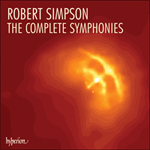
Welcome to Hyperion Records, an independent British classical label devoted to presenting high-quality recordings of music of all styles and from all periods from the twelfth century to the twenty-first.
Hyperion offers both CDs, and downloads in a number of formats. The site is also available in several languages.
Please use the dropdown buttons to set your preferred options, or use the checkbox to accept the defaults.

The 'Allegro grazioso' begins and ends in B, with two big climaxes in E flat and G respectively. It adopts a gently swinging, fast triple-time pulse that suggests a faint reminiscence of Nielsen, one of Simpson's lifelong idols. The movement begins quietly, but with a great sense of latent energy as the music naturally evolves from the initial motif heard at the outset on violins and violas.
Placed on either side of the two climaxes are two fugatos: the first for strings alone is strong, determined, whereas the second, begun by the woodwind, skips along with much mischief and jollity. After the second climax has subsided, the opening theme returns at a slower tempo, gradually fading away into silence as the first bar of the Symphony is repeated several times.
The slow movement is placed second and is cast as a theme with thirteen variations on a gravely beautiful unharmonised viola melody which revolves gently from E flat to G. In fact, with the exception of the last five bars, the movement is strictly palindromic, so that the oscillation between keys is reversed half way through. The middle variations, which are all pianissimo, seem to provide a 'still centre' to the whole Symphony and perhaps evoke the immensities of a nocturnal, star-lit sky.
The Finale returns to the original key of B. It is a strong, stamping movement with a tigerish energy and rhythmic drive similar in spirit to the last movement of Beethoven's Seventh Symphony which is acknowledged as an important influence. As with the Beethoven, it is astonishing to hear how Simpson can make this Finale roar whilst still employing an orchestra of relatively modest proportions. The overall structure mirrors that of the opening Allegro, with the first climax in E flat and the recapitulation grafted on to the second climax in G. An extended coda is needed to restore the key of B with the greatest force. When this is achieved the movement ends abruptly with considerable vigour.
from notes by Matthew Taylor © 1992
 Simpson: The Complete Symphonies Simpson: The Complete Symphonies‘One of the outstanding recording projects of our time … this Hyperion series deserves to stand as a monument while other more superficially gla ... ‘One of the best-kept secrets of post-war British Music … utterly compelling’ (The Guardian)» More |

